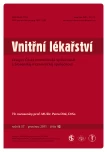Do we need endoscopic sclerotherapy of oesophageal varices or the last turn off the light
Authors:
M. Bátovský
Authors‘ workplace:
Gastroenterologická klinika Lekárskej fakulty Slovenskej zdravotníckej univerzity a UN Bratislava, Slovenská republika, prednosta doc. MUDr. Marian Bátovský, CSc., mim. prof. SZU
Published in:
Vnitř Lék 2011; 57(12): 989-992
Category:
70th birthday of prof. MUDr. Petr Dítě, DrSc.
Overview
For the primary prophylaxis of variceal bleeding endoscopic band ligation has been shown to be as effective as non-selective beta-blockers (carvedilol), but variceal injection sclerotherapy is not generaly recommended in this setting because of higher rate of complications and lower effect in reducing either bleeding or mortality. Endoscopic management of acutely bleeding gastroesophageal varices includes injection sclerotherapy, rubber band ligation, and variceal obturation with tissue adhesives. Variceal injection sclerotherapy remains a quick, simple and cheap technique for the control of active bleeding from esophageal varices, but is associated with more re-bleeding than variceal band ligation, which is now preferred also for lower rate of complications. Endoscopic sclerotherapy has increasingly been replaced by ligation also in secondary prophylaxis of variceal bleeding. The studies showed that band ligation can eradicate varices in fewer sessions, re-bleeding and complications were fewer in comparison with variceal injection sclerotherapy. Because of the reduced efficacy, severe complications, and the high mortality associated with using conventional sclerosants in acute bleeding gastric varices, the technique of injecting tissue adhesives has been studied, described and used despite numerous complications. Endoscopic injection sclerotherapy of esophageal varices remains usable as an oldest method in arresting of this hemorrhage only in rare cases when the band ligation is not available.
Key words:
portal hypertension – variceal hemorrhage – endoscopic ligation – sclerotherapy
Sources
1. Helmy A, Hayes PC. Review article: Current endoscopic therapeutic options in the management of variceal bleeding. Aliment Pharmacol Ther 2001; 15: 575–594.
2. Cárdenas A. Management of acute variceal bleeding: emphasis of endoscopic therapy. Clin Liver Dis 2010; 14: 251–262.
3. Lo GH. Management of acute esophageal variceal hemorrhage. Kaohsjung J Med Sci 2010; 26: 55–66.
4. DeGottardi A, Dufour JF. Die akute Ösophagusvarizenblutung. Internist Prax 2009; 49: 103–109.
5. Bosch J, Abraldas JG, Berzigotti A et al. Portal hypertension and gastrointestinal bleeding. Semin Liver Dis 2008; 28: 3–25.
6. Carey W. Portal hypertension: Diagnosis and management with particular reference to variceal hemorrhage. J Dig Dis 2011; 12: 25–32.
7. Miñano C, Garcia-Tsao G. Clinical pharmacology of portal hypertension. Gastroenterol Clin North Am 2010; 39: 681–695.
8. D’Amico G, Pagliaro L, Pietrosi G et al. Emergency sclerotherapy versus vasoactive drugs for bleeding oesophageal varices in cirrhotic patients. Cochrane Database Syst Rev 2010; 3: CD002233.
9. de Franchis R, Baveno V. Faculty. Revising consensus in portal hypertension: Report of the Baveno V consensus workshop on methodology of diagnostic and therapy in portal hypertension. J Hepatol 2010; 53: 762–768.
10. Triantos CK, Burroughs AK. Treatment of acute variceal bleeding. Ann Gastroenterol 2008; 21: 154–160.
11. Connolly M, Bhatt A, Wechovski J et al. An economic evaluation of vasoactive agents used to treat acute bleeding oesophageal varices in Belgium. Acta Gastroenterol Belg 2008; 71: 230–236.
12. de Franchis R, Dell’Era A. Novel developments in esophageal vascular disorders. Curr Opin Gastroenterol 2008; 24: 490–495.
13. Abid S, Jafri W, Hamid S et al. Terlipressin vs. octreotide in bleeding esophageal varices as an adjuvant therapy with endoscopic band ligation: a randomized double-blind placebo-controlled trial. Am J Gastroenterol 2009; 104: 617–623.
14. Bochnia M, Abdulhabib A, Zatoński M et al. Esophageal varices. Part I – pathophysiology, diagnostics, conservative treatment and prevention of bleeding. Adv Clin Exp Med 2008; 17: 351–357.
15. Hobolth L, Krag A, Bendsten F. The recent reduction in mortality from bleeding oesophageal varices is primarily observed from days 1–5. Liver Int 20010; 30: 455–462.
16. Schepke M. Stellenwert der medikamentosen Pfortaderdrucksenkung im Therapiekonzept der Varizenblutung. Dtsch Med Wochenschr 2009; 134: 1823–1827.
17. Villanueva C, Balanzó J. Variceal bleeding: pharmacological treatment and prophylactic strategies. Drugs 2008; 68: 2303–2324.
18. Garcia-Pagan JC, DeGottardi A, Bosch J. Review article: The modern management of portal hypertension – primary and secondary prophylaxis of variceal bleeding in cirrhotic patients. Aliment Pharmacol Ther 2008; 28: 178–186.
19. Gonzales R, Zamora J, Gomez-Camarero J et al. Meta-analysis: Combination endoscopic and drug therapy to prevent variceal rebleeding in cirrhosis. Ann Int Med 2008; 149: 109–122.
20. Mönkemüller K, Fry LC. Endoscopic therapy for gastric varices. In: Mönkemüller K, Wilcox CM, Muñoz-Navas M (eds). Interventional and therapeutic gastrointestinal endoscopy. Basel: Fron Gastroent Res, Karger 2010: 64–69.
21. Bosch J, Abraldes JG, Berzigotti A et al. The clinical use of HVPG measurements in chronic liver disease. Nat Rev Gastroenterol Hepatol 2009; 6: 573–582.
Labels
Diabetology Endocrinology Internal medicineArticle was published in
Internal Medicine

2011 Issue 12
Most read in this issue
- Neuroendocrine tumours of the upper gastrointestinal tract, characteristics and comparison of localization diagnostics
- Complications of endoscopic retrograde cholangiopancreatography and how to minimize them
- Aldosterone as an endogenous cardiovascular toxin and the options for its therapeutic management
- Do we need endoscopic sclerotherapy of oesophageal varices or the last turn off the light
